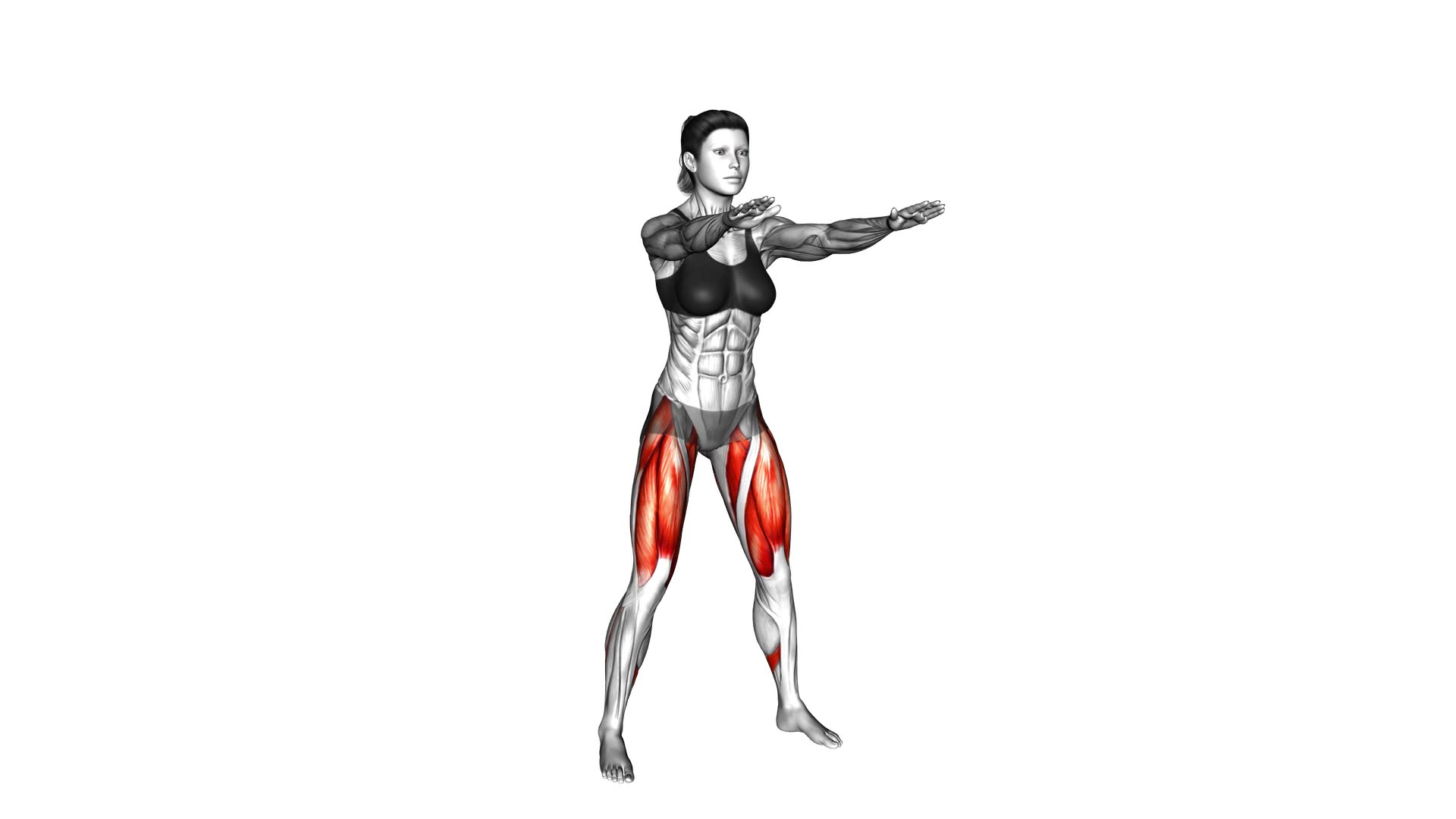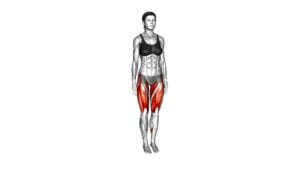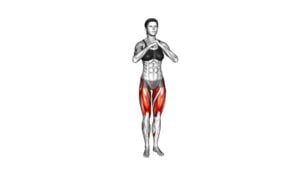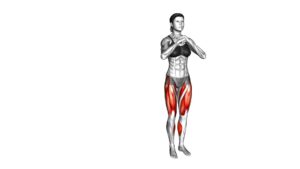Side-to-Side Squat (female) – Video Exercise Guide & Tips

Are you looking to add a challenging lower body exercise to your workout routine? Look no further than the side-to-side squat!
Watch This Exercise Video
This move targets your glutes, thighs, and hips, helping to tone and strengthen your lower body.
In this video exercise guide, we'll walk you through the proper form and technique, as well as provide helpful tips and variations.
Get ready to take your squats to the next level and achieve your fitness goals!
Let's get started.
Key Takeaways
- The side-to-side squat targets the glutes, thighs, and hips, toning and strengthening the lower body muscles.
- Proper form and technique are crucial, including maintaining correct body alignment, engaging core muscles, and avoiding knee caving.
- Common mistakes to avoid include leaning forward, allowing knees to cave in, and not going low enough.
- The exercise can be modified and customized to individual needs and abilities, and can be done with or without equipment.
Benefits of the Side-to-Side Squat
By performing the Side-to-Side Squat, you can effectively engage your lower body muscles while improving your balance and stability. This exercise specifically targets your quadriceps, hamstrings, glutes, and calves, making it a great addition to your lower body workout routine. The side-to-side movement engages different muscle groups compared to traditional squats, providing a well-rounded lower body workout.
One of the benefits of the Side-to-Side Squat is that it can be modified to accommodate various fitness levels. If you're new to this exercise, you can start by performing the movement without weights. As you become more comfortable and stronger, you can gradually add dumbbells or kettlebells to increase the intensity.
Another advantage of the Side-to-Side Squat is that it helps improve your balance and stability. By shifting your weight from side to side, you challenge your body to maintain control and coordination. This can be especially beneficial for athletes, seniors, or anyone looking to enhance their overall balance and stability.
Incorporating the Side-to-Side Squat into your workout routine can help you develop stronger lower body muscles, improve your balance, and enhance your stability. Remember to start with modified versions if needed and gradually increase the intensity as you progress. Engage those muscles and start reaping the benefits of this effective exercise.
Proper Form and Technique
To perform the Side-to-Side Squat with proper form and technique, there are a few key points to keep in mind.
First, make sure to maintain correct body alignment by keeping your chest up, shoulders back, and spine neutral throughout the movement.
Second, be mindful of avoiding knee caving, which is when your knees collapse inward.
Lastly, engage your core muscles by drawing your belly button towards your spine to stabilize your torso and support the movement.
Correct Body Alignment
Maintain proper body alignment during the Side-to-Side Squat exercise by engaging your core and keeping your back straight.
Body alignment is of utmost importance as it ensures correct posture and reduces the risk of injury. By engaging your core muscles, you create a strong foundation that supports your spine and keeps it in alignment. This helps distribute the load evenly and prevents excessive strain on your joints.
Additionally, keeping your back straight throughout the exercise helps maintain proper spinal alignment and prevents rounding or arching. By being aware of correct posture and body alignment, you can optimize the effectiveness of the Side-to-Side Squat and minimize the risk of discomfort or injury.
Avoid Knee Caving
To ensure proper form and technique during the Side-to-Side Squat exercise, it's important that you focus on avoiding knee caving. Knee alignment plays a crucial role in preventing knee injuries and maintaining stability. Here are some tips to help you avoid knee caving:
- Keep your knees aligned with your toes throughout the movement.
- Engage your glutes and thigh muscles to support your knees.
- Maintain a neutral spine and engage your core to stabilize your body.
It's essential to prioritize knee alignment to prevent common knee injuries such as ACL tears or meniscus damage. By maintaining proper form and technique, you reduce the risk of placing excessive stress on your knees.
Now that you understand how to avoid knee caving, let's move on to the next section and learn how to engage your core muscles.
Engage Core Muscles
Focus on engaging your core muscles to maintain proper form and technique during the Side-to-Side Squat exercise. Core stability is crucial for performing functional movements effectively and efficiently.
By activating your core muscles, you create a solid foundation that supports your entire body throughout the exercise. To engage your core, start by drawing your belly button towards your spine, as if you were trying to zip up a tight pair of jeans. This action activates your deep abdominal muscles, such as the transverse abdominis.
Additionally, focus on maintaining a tall posture, keeping your chest lifted and your shoulders relaxed. By engaging your core, you enhance your stability and control, allowing you to perform the Side-to-Side Squat exercise with proper form and technique.
Common Mistakes to Avoid
When performing the Side-to-Side Squat, be mindful of these common errors to optimize your form and maximize the benefits of the exercise. Proper technique is crucial to prevent injury and ensure effective results. Here are some common mistakes to avoid:
- Leaning forward: One of the most common mistakes is leaning forward during the squat. This puts unnecessary strain on your lower back and decreases the activation of your leg muscles. Keep your chest up and maintain an upright posture throughout the movement.
- Allowing knees to cave in: Another mistake to avoid is letting your knees cave inwards. This not only puts stress on your knees but also reduces the effectiveness of the exercise. Make sure to push your knees outwards and maintain proper alignment with your toes.
- Not going low enough: Many people tend to perform shallow squats, missing out on the full range of motion and the benefits it offers. Aim to squat as low as you comfortably can, ensuring your thighs are parallel to the ground or even lower. This engages your glutes and hamstrings more effectively.
By being aware of these common mistakes and focusing on proper technique, you can ensure that you're getting the most out of your Side-to-Side Squat exercise.
Remember to start with a weight that's appropriate for your fitness level and gradually increase as you become more comfortable with the movement. Keep practicing and refining your form to achieve optimal results.
Variations and Modifications
Let's explore some options for progressing the Side-to-Side Squat if you're a beginner.
You can start by performing the exercise without any weights and gradually add resistance as you get stronger.
For those looking for a challenge, incorporating equipment like dumbbells or a resistance band can intensify the workout.
Additionally, modifying the exercise by reducing the range of motion or using a stability ball can help individuals with mobility or balance limitations reap the benefits of this movement.
Progression Options for Beginners
Improve your squat technique as a beginner by incorporating variations and modifications. As you progress in your fitness journey, it's important to challenge yourself and gradually increase the difficulty of your exercises.
Here are three progression options for beginners to take their side-to-side squats to the next level:
- Increase the range of motion: Start by squatting to a comfortable depth and gradually work towards squatting lower. This will help improve your flexibility and strength.
- Add resistance: Incorporate dumbbells or a resistance band to make the exercise more challenging. Hold the weights at your sides or place the band around your thighs to engage your muscles even more.
- Plyometric side-to-side squats: Once you have mastered the basic side-to-side squat, you can add a jump to the movement. Push off the ground explosively as you switch sides, landing softly with bent knees.
Equipment for Advanced Variations
As you progress in your fitness journey and continue challenging yourself with side-to-side squats, it's time to explore the equipment options available for advanced variations and modifications.
Incorporating advanced equipment can take your side-to-side squats to the next level, providing even more challenge and intensity to your workout. Some examples of advanced equipment that you can use include resistance bands, weighted vests, and dumbbells. By adding resistance to your side-to-side squats, you'll engage additional muscle groups and increase the difficulty of the exercise.
Additionally, you can also try challenging modifications such as adding a jump or incorporating a stability ball. These modifications will further challenge your balance and coordination while targeting different muscle groups.
Now that you know about the advanced equipment and challenging modifications available, let's explore the benefits of modified versions in the next section.
Benefits of Modified Versions
To maximize your workout and target specific muscle groups, try incorporating modified versions of the side-to-side squat. These alternative exercises provide unique benefits that can help you achieve your fitness goals.
Here are three reasons why you should consider adding modified versions to your routine:
- Increased intensity: Modified versions of the side-to-side squat often require more effort and engage additional muscles. This can result in a higher calorie burn and improved overall strength.
- Targeted muscle activation: By modifying the side-to-side squat, you can focus on specific muscle groups such as the glutes, quads, or inner thighs. This allows you to tailor your workout to your individual needs and goals.
- Joint-friendly options: Some modified versions offer a lower impact alternative, making them suitable for individuals with joint issues or injuries. This allows you to continue working out while minimizing the risk of further discomfort or injury.
Incorporating modified versions of the side-to-side squat into your exercise routine can provide a range of benefits, from increased intensity to targeted muscle activation and joint-friendly options. Experiment with different variations to find the ones that work best for you.
Tips for Incorporating the Side-To-Side Squat Into Your Workout Routine
Incorporate the side-to-side squat into your workout routine for an effective lower body exercise. This exercise targets your glutes, quads, and inner and outer thighs, helping to strengthen and tone these areas. To make the side-to-side squat more challenging, you can try some modifications. For instance, you can hold a dumbbell or kettlebell in front of your chest as you perform the squat. This added weight will increase the resistance and intensity of the exercise. Another modification is to add a jump at the end of each squat, increasing the cardiovascular component and making it a plyometric exercise.
You can also incorporate side-to-side squats into your HIIT (High-Intensity Interval Training) workouts. HIIT workouts involve short bursts of intense exercise followed by brief recovery periods. Side-to-side squats can be a great addition to this type of workout, as they can be performed quickly and require no equipment. Try incorporating 30 seconds of side-to-side squats into your HIIT routine, alternating with other exercises such as burpees or mountain climbers. This will help to keep your heart rate up and maximize calorie burn.
Remember to focus on proper form and engage your core throughout the exercise. Start by standing with your feet shoulder-width apart, then step to the side and lower your body into a squat position. Push through your heel to return to the starting position and repeat on the other side. Incorporating side-to-side squats into your workout routine will help you achieve a stronger lower body and improve your overall fitness level.
Safety Precautions and Considerations
When incorporating the side-to-side squat into your workout routine, it's important to consider safety precautions and take appropriate measures to avoid injury. By following these safety measures, you can ensure a safe and effective workout:
- Warm up: Before starting any exercise, it's crucial to warm up your muscles and joints. Perform dynamic stretches like leg swings and hip circles to increase blood flow and prepare your body for the side-to-side squat.
- Proper form: Maintain proper form throughout the exercise to prevent strain or injury. Keep your feet shoulder-width apart, toes pointing forward, and knees aligned with your toes. Engage your core and keep your back straight as you lower into the squat.
- Start with lighter weights: If you're using weights or resistance bands, start with lighter ones and gradually increase the intensity. This will help you build strength and stability while reducing the risk of injury.
Frequently Asked Questions
Can the Side-To-Side Squat Help Improve Balance and Stability?
The side-to-side squat is a great exercise for improving balance and stability. By incorporating this movement into your routine, you can enhance coordination and increase core strength.
This exercise requires you to shift your weight from side to side, challenging your body to maintain stability throughout. It targets the muscles in your legs, hips, and core, helping you to build a solid foundation of strength and stability.
Try adding the side-to-side squat to your workout for improved balance and stability.
How Many Calories Can I Burn by Doing Side-To-Side Squats?
To burn calories and target multiple muscle groups, side-to-side squats are a great choice. By incorporating lateral movements and engaging your glutes, quads, and inner thighs, this exercise can help you torch calories and build strength.
While the exact number of calories burned during side-to-side squats depends on factors like intensity and duration, you can expect to see significant results when combined with a balanced diet and regular exercise routine.
Is It Necessary to Use Weights While Performing the Side-To-Side Squat?
Using weights while performing the side-to-side squat isn't necessary, but it can offer additional benefits. Side-to-side squats without weights still engage your leg and glute muscles, helping to strengthen and tone them. Adding weights can increase the resistance, making the exercise more challenging and potentially leading to greater muscle growth.
However, if you're new to this exercise or prefer a lighter workout, you can still achieve results without using weights. It all depends on your fitness goals and preferences.
Can the Side-To-Side Squat Target Specific Muscle Groups?
The side-to-side squat is a great exercise for targeting specific muscle groups. By shifting your weight from one leg to the other, you engage your glutes, quads, and inner thighs. This movement helps to strengthen and tone these areas.
To add variety to your workout, you can try different variations of the side-to-side squat, such as holding weights or using a resistance band. These variations can further challenge your muscles and provide even more benefits.
Are There Any Modifications for People With Knee or Hip Issues?
If you have knee or hip issues, there are modifications you can make to the side-to-side squat. Instead of squatting deeply, try doing a more shallow squat to reduce strain on your joints. You can also use a stability ball or a chair for support.
Even with modifications, side-to-side squats can still provide benefits for your overall fitness. They can improve your lower body strength, stability, and balance. Remember to listen to your body and stop if you feel any pain or discomfort.
Conclusion
Incorporating the side-to-side squat into your workout routine can be a great way to strengthen your lower body and improve balance. By following proper form and avoiding common mistakes, you can maximize the benefits of this exercise.
With variations and modifications available, you can tailor the side-to-side squat to your fitness level and goals. Remember to prioritize safety by listening to your body and consulting with a fitness professional if needed.
Get ready to feel the burn and see results with this effective exercise!

Author
Years ago, the spark of my life’s passion ignited in my mind the moment I stepped into the local gym for the first time. The inaugural bead of perspiration, the initial endeavor, the very first surge of endorphins, and a sense of pride that washed over me post-workout marked the beginning of my deep-seated interest in strength sports, fitness, and sports nutrition. This very curiosity blossomed rapidly into a profound fascination, propelling me to earn a Master’s degree in Physical Education from the Academy of Physical Education in Krakow, followed by a Sports Manager diploma from the Jagiellonian University. My journey of growth led me to gain more specialized qualifications, such as being a certified personal trainer with a focus on sports dietetics, a lifeguard, and an instructor for wellness and corrective gymnastics. Theoretical knowledge paired seamlessly with practical experience, reinforcing my belief that the transformation of individuals under my guidance was also a reflection of my personal growth. This belief holds true even today. Each day, I strive to push the boundaries and explore new realms. These realms gently elevate me to greater heights. The unique combination of passion for my field and the continuous quest for growth fuels my drive to break new ground.







